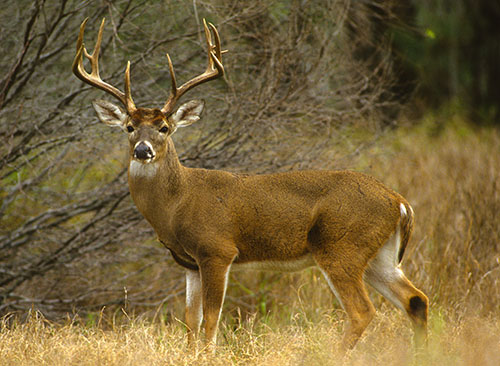Feedstuffs for wild deer
Jan 10, 2022

For the most part, specific nutritional requirements of deer (cervids} are not well defined. It is known, however, that benefit is seen by increasing wild deer nutrition, particularly after the first frost, for improvement of body stores for winter & increased survival (Note that attempting to maintain body condition will take precedent over antler growth during energy partitioning). Deer are very efficient in adapting to survival with dwindling availability of feedstuffs. When supplementing wild deer rations, always remember the first step is to check the law for the authorized period of time to feed wildlife.
Animal consumption should include basic nutrients such as protein, energy (carbohydrate & fat), vitamin, mineral & very importantly, water. Although deer are ruminant animals just like cows, their rumen will only hold about 4% of a cow's rumen. Thus, deer must replenish approximately every three to four hours. The main source of nutrition for deer comes in the form of browse including woody-type plants, stems, shrubs & leaves. More concentrated sources of energy for deer include nuts & fruits. Many times, forages & browse become less available & are of questionable quality. It is not uncommon for bucks to lose as much as 30% of their bodyweight due to the stress of the rut. Offering supplemental feed won't eliminate body weight loss, but deer will still utilize the supplement as a portion of their diet even if total daily intake has fallen off.
When supplementing rations, it is typical to use ingredients with higher energy concentrations. It is common to supplement with corn due to its starch & fat content. But, corn will only yield approximately 8-9% crude protein (CP} on a dry matter basis which falls well short of desired CP needs. Adding whole, roasted soybeans to corn significantly increases CP & CP quality while supplying necessary fats. Additionally, supplying calcium (Ca} & phosphorous (P} along with magnesium (Mg} & other trace minerals greatly supports the animal’s ability to maintain muscle function, bone maintenance & antler development. Since cervids typically utilize browse as basal ration, supplemental vitamins including vitamins A, D, E & B-complex aid the animal in maintaining metabolic bodily function.
In properly providing wildlife the most optimal nutrition, remember that season & life-cycle stage plays a part in requirements. Consider the following in deciding if feeding deer is advantageous:
For more content like this, check out the latest issue of the Cooperator.
Animal consumption should include basic nutrients such as protein, energy (carbohydrate & fat), vitamin, mineral & very importantly, water. Although deer are ruminant animals just like cows, their rumen will only hold about 4% of a cow's rumen. Thus, deer must replenish approximately every three to four hours. The main source of nutrition for deer comes in the form of browse including woody-type plants, stems, shrubs & leaves. More concentrated sources of energy for deer include nuts & fruits. Many times, forages & browse become less available & are of questionable quality. It is not uncommon for bucks to lose as much as 30% of their bodyweight due to the stress of the rut. Offering supplemental feed won't eliminate body weight loss, but deer will still utilize the supplement as a portion of their diet even if total daily intake has fallen off.
When supplementing rations, it is typical to use ingredients with higher energy concentrations. It is common to supplement with corn due to its starch & fat content. But, corn will only yield approximately 8-9% crude protein (CP} on a dry matter basis which falls well short of desired CP needs. Adding whole, roasted soybeans to corn significantly increases CP & CP quality while supplying necessary fats. Additionally, supplying calcium (Ca} & phosphorous (P} along with magnesium (Mg} & other trace minerals greatly supports the animal’s ability to maintain muscle function, bone maintenance & antler development. Since cervids typically utilize browse as basal ration, supplemental vitamins including vitamins A, D, E & B-complex aid the animal in maintaining metabolic bodily function.
In properly providing wildlife the most optimal nutrition, remember that season & life-cycle stage plays a part in requirements. Consider the following in deciding if feeding deer is advantageous:
- Make sure to check legal availability to supplement wildlife.
- Spring & summer play important roles in deer growth since deer have lower requirements in winter.
- Remember that deer are ruminant animals. It is best to make diet changes slowly and gradually instead of rapidly.
For more content like this, check out the latest issue of the Cooperator.